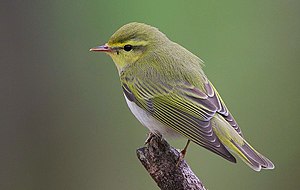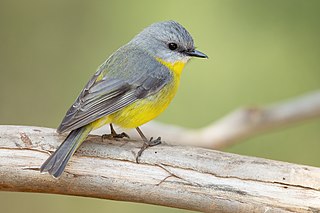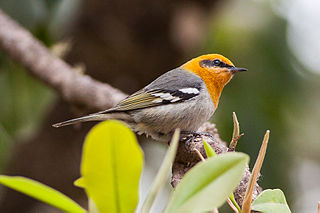

Various Passeriformes (perching birds) are commonly referred to as warblers. They are not necessarily closely related to one another, but share some characteristics, such as being fairly small, vocal, and insectivorous.


Various Passeriformes (perching birds) are commonly referred to as warblers. They are not necessarily closely related to one another, but share some characteristics, such as being fairly small, vocal, and insectivorous.
These are somewhat more closely related to each other than to other warblers. They belong to a superfamily also containing Old World babblers, bulbuls, etc.
The two families of American warblers are part of another superfamily, which unites them with New World sparrows, buntings, finches, etc.
These are closely related to the tits and chickadees
These are the most distinct group of warblers. They are not closely related at all to the others, but rather to the honeyeaters and fairy-wrens.

A passerine is any bird of the order Passeriformes which includes more than half of all bird species. Sometimes known as perching birds, passerines generally have an anisodactyl arrangement of their toes, which facilitates perching.

A songbird is a bird belonging to the suborder Passeri of the perching birds (Passeriformes). Another name that is sometimes seen as the scientific or vernacular name is Oscines, from Latin oscen, "songbird". The Passeriformes contains 5,000 or so species found all over the world, in which the vocal organ typically is developed in such a way as to produce a diverse and elaborate bird song.
The Old World warblers are a large group of birds formerly grouped together in the bird family Sylviidae. They are not closely related to the New World warblers. The family held over 400 species in over 70 genera, and were the source of much taxonomic confusion. Two families were split out initially, the cisticolas into Cisticolidae and the kinglets into Regulidae. In the past 20–30 years they have been the subject of much research and many species are now placed into other families, including the Acrocephalidae, Cettiidae, Phylloscopidae, and Megaluridae. In addition some species have been moved into existing families or have not yet had their placement fully resolved. Only a small number of warblers, in just two genera, are now retained in the family Sylviidae.

The New World warblers or wood-warblers are a group of small, often colorful, passerine birds that make up the family Parulidae and are restricted to the New World. The family contains 120 species. They are not closely related to Old World warblers or Australian warblers. Most are arboreal, but some, like the ovenbird and the two waterthrushes, are primarily terrestrial. Most members of this family are insectivores.

Sylviidae is a family of passerine birds that includes the typical warblers Sylvia, and closely related genus Curruca, formerly included in Sylvia. They are found in Eurasia and Africa, with the greatest diversity in the Mediterranean region.

The parrotbills are a family, Paradoxornithidae, of passerine birds that are primarily native to East, Southeast and South Asia, with a single species in western North America, though feral populations exist elsewhere. They are generally small birds that inhabit reedbeds, forests and similar habitats. The traditional parrotbills feed mainly on seeds, e.g. of grasses, to which their robust bill, as the name implies, is well-adapted. Members of the family are usually non-migratory.

The olive warbler is a small passerine bird. It is the only member of the genus Peucedramus and the family Peucedramidae.

Bush-warblers are small insectivorous songbirds of the genera Cettia, Horornis, and Bradypterus. They were formerly placed in the "wastebin" Old World warbler family. None of the genera as traditionally delimited are believed to be monophyletic.

The Nashville warbler is a small songbird in the New World warbler family, found in North and Central America. It breeds in parts of the northern and western United States and southern Canada, and migrates to winter in southern California and Texas, Mexico, and the north of Central America. It has a gray head and a green back, and its underparts are yellow and white.

The wrentit is a small bird that lives in chaparral, oak woodlands, and bushland on the western coast of North America. It is the only species in the genus Chamaea.

The nine-primaried oscines is a group of bird families in the suborder Passeri (oscines) of the Passeriformes. The composition of the group has changed since the term was introduced but is now considered to consist of seven major families—Fringillidae, Emberizidae, Cardinalidae, Thraupidae, Passerellidae, Parulidae and Icteridae—plus some small families. When Fringillidae is omitted the remaining six families are referred to as the "New World" nine-primaried oscines.

The ashy-throated parrotbill is a parrotbill. In old sources, it may be called Alphonse's crow-tit; though superficially resembling a tit it is not a member of the Paridae. The native range of this species extends from south-west China to northern Vietnam, and it might have become naturalised in one area in Italy.

Cardellina is a genus of passerine birds in the New World warbler family Parulidae. The genus name Cardellina is a diminutive of the Italian dialect word Cardella for the European goldfinch.

Passerida is, under the Sibley-Ahlquist taxonomy, one of two parvorders contained within the suborder Passeri. While more recent research suggests that its sister parvorder, Corvida, is not a monophyletic grouping, the Passerida as a distinct clade are widely accepted.

Stenostiridae, or the fairy flycatchers, are a family of small passerine birds proposed as a result of recent discoveries in molecular systematics. They are also referred to as stenostirid warblers.

The Beijing babbler, also known as the white-browed Chinese warbler, Chinese hill warbler, or Chinese bush-dweller, is a species of bird in the genus Rhopophilus. It is now thought to be a close relative of the parrotbills and is placed in the family Paradoxornithidae; previously, it was placed in the families Cisticolidae, Timaliidae or Sylviidae. It is found in northern China and North Korea, and formerly occurred in South Korea. The species was first described by Robert Swinhoe in 1868.

Sylvioidea is a superfamily of passerine birds, one of at least three major clades within the Passerida along with the Muscicapoidea and Passeroidea. It contains about 1300 species including the Old World warblers, Old World babblers, swallows, larks and bulbuls. Members of the clade are found worldwide, but fewer species are present in the Americas.

The African warblers are a newly erected family Macrosphenidae, of African songbirds. Most of the species were formerly placed in the Old World warbler family Sylviidae, although one species, the rockrunner, was placed in the babbler family, Timaliidae. A series of molecular studies of the Old World warblers and other bird families in the superfamily Sylvioidea found that the African warblers were not part of Sylviidae but were instead an early (basal) offshoot of the entire clade Sylvioidea. Some taxonomic authorities place the entire family Hyliidae here.